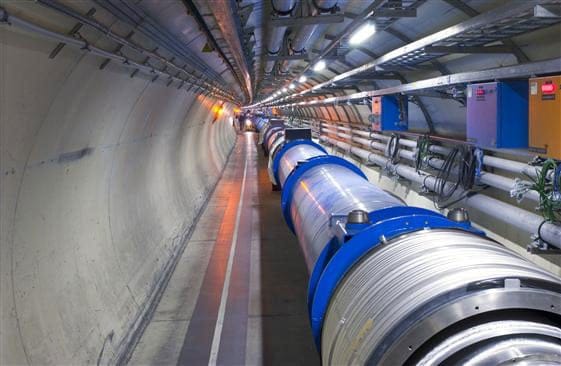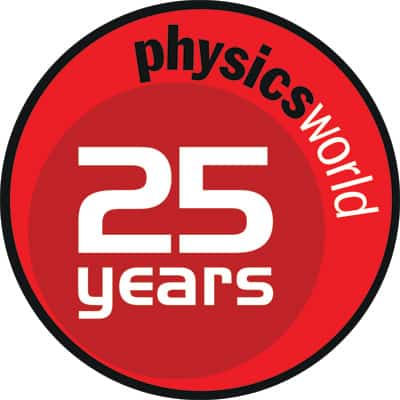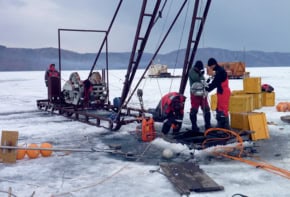
Historians of physics will surely remember 2012 as the year when the Higgs boson – or a particle that looks very much like it – was finally discovered at the Large Hadron Collider (LHC) at CERN. Indeed, it should come as no surprise that the discovery was picked by us as the Physics World Breakthrough of the Year for 2012. The choice was an obvious one – too obvious perhaps – but it was one that we could hardly have overlooked. Yet for anyone who fears that Physics World is obsessed with particle physics – no, we’re not: the rest of our top 10 breakthroughs include everything from optics and astronomy to energy harvesting and the spooky properties of “twisted” light.
But what will happen in the world of physics in 2013? What will be the key discoveries of the year, who will make them and where? The beauty of physics, of course, is that no-one knows for sure. But that hasn’t stopped us here at Physics World from gazing into our (quasi) crystal ball and making our predictions for what we think will happen next year, what might take place – and what definitely won’t. One thing is for sure: we will be here to cover the world of physics next year.
Shut down and calculate
Over at CERN, physicists can expect a busy start to the year as they capture their final data from the LHC – in the form of proton and lead-ion collisions – before the collider enters a scheduled 24-month shutdown, starting on 11 February. Teams of engineers will then begin the lengthy business of fixing about 1000 defective interconnects so that the collider’s magnets can operate closer to their target bending field of 8.3 T, which ought to allow the LHC to collide particles with a total energy of at least 13 TeV starting in 2015.
The down-time in 2013 will give physicists a breather as they comb through the existing LHC data, which has been spewing out at a rate of several gigabytes per second in recent months. You can therefore expect to see a further flurry of papers about the properties of the new boson being written and then immediately dissected on blogs by the likes of Adam Falkowski, Phillip Gibbs, Matt Strassler and Peter Woit. However, we predict that firm signs of supersymmetry – the theory that could unify the weak, strong and electromagnetic forces at energies of about 1016 GeV – will be few and far between in 2013. Sorry, SUSY-lovers.
For those who are interested, CERN has a fascinating dashboard that anyone can view to keep track of the LHC’s current status. Although the collider will be down for most of 2013, we predict further debate among CERN staff in the coming year over when exactly – or even if – the LHC will be able to reach its top design energy of 14 TeV. CMS spokesperson Joe Incandela told Physics World last week that the current plan is “to ramp up to 13 TeV in the next run after the shutdown” but that going higher will be “not so practical” for the experiments. The problem, it seems, is that to get from 13 TeV,to 14 TeV, the magnets would have to be warmed up, cooled down again and then “retrained”, which takes a long time. “I believe that they will stay at 13 TeV at least for an initial meaningful period to allow us to have a decent consistent dataset,” notes Incandela.
Another matter of contention in 2013 will be which particle physicists – if any – will bag the year’s Nobel Prize for Physics
Another matter of contention in 2013 will be which particle physicists – if any – will bag the year’s Nobel Prize for Physics. Nominations for the prestigious award close at the end of January and Peter Higgs is surely a shoo-in for predicting the existence of the particle that bears his name. However, the members of the Royal Swedish Academy of Sciences will have a tough choice deciding which two other people (it can only be two) should share the prize with him. Other theorists? Or some combination of LHC scientists, such as some of the seven who earlier this month shared the new $3m prize from the Russian physicist-turned-entrepreneur Yuri Milner’s Fundamental Physics Prize Foundation?
It is a messy business because, as Higgs himself pointed out in an audio interview with Physics World last year, at least five other theorists – (the late) Robert Brout, François Englert, Gerald Guralnik, Carl Hagen and Tom Kibble – deserve credit for predicting the Higgs boson, and possibly Philip Anderson too. Our prediction is that the Nobel wonks will, after much agonizing, award the prize to Higgs, Englert and Anderson. (Brout, who previously shared the Wolf prize in 2004 with Higgs and Englert, died in 2011.) But with the Nobel-prize pot having shrunk by 20% this year to about $1.1m, Milner’s new $3m is likely to take even more of a centre stage next year.
Looking to the heavens
Away from particle physics, there are some interesting astronomy and space-science missions set for launch in 2013. They include China’s first ever lunar rover – Chang’e 3 – as well as a NASA mission (LADEE) to gather information about the Moon’s surface and its dust, which could be useful data for anyone planning to set up a lunar base. NASA will also launch one craft (MAVEN) for studying the Martian atmosphere and another (ISIS – postponed from 2012) for probing the corona and solar wind.
Not to be outdone, the European Space Agency (ESA) has its own launch programme, which includes the Sentinel-1 Earth-observation craft, its Gaia star-cataloguing mission, and a constellation of three satellites in different polar orbits, known as Swarm, to monitor the Earth’s magnetic field (also held over from 2012). Continuing the US’s shift towards commercial space transport in the wake of the retirement of its space-shuttle programme, 2013 should also see two further missions to the International Space Station from SpaceX and a demonstration flight by the Orbital Sciences Corporation of its Cygnus spacecraft, which will also aim to reach the ISS.
Over in cosmology, 2013 will be the year when bucketloads of new data about the early universe emerge from ESA’s Planck mission, with the start of April seeing a major meeting in the Netherlands at which researchers will take an in-depth look at its initial scientific results. These scientists will be able to get their hands on “temperature maps” of the whole sky at nine different frequencies, which will reveal more details of the anisotropies of the cosmic microwave background. The maps will also provide fascinating new information about everything from the Milky Way to the energy “kick” given to CMB photons passing through the hot gases of large galaxy clusters – what is known as the Sunyaev–Zel’dovich effect. And for all you amateur astronomers out there, keep an eye out for next November, when a newly discovered “supercomet” called ISON, some 15 times brighter than the Moon, could cross the night sky in spectacular fashion.
Small is beautiful
But next year, as always, most physicists will do work that is much smaller in scale and, dare one say, be more practical and relevant to the real world than anything in astronomy, particle physics and cosmology. Unfortunately, it is always harder to say what the breakthroughs in such fields will be, but you can certainly expect plenty of eye-popping advances in metamaterials, graphene, cold-atom research and quantum communication and computation, to name but four.
Tight science funding will continue to weigh heavily on physicists’ minds in 2013, as it does every year. In tough economic times, some countries will come to the narrow-minded conclusion that investing in science is a luxury they can ill avoid and scientists in these nations will have a job on their hands persuading politicians to defend their corner. But strong funding for science is, in fact, an essential tool in boosting growth, with Germany, for example, having recently decided to increase its science budget in 2013 by 6%.
And although not everything has plain sailing in the US for funding in recent times, America has been fortunate in having Steven Chu – a physicist and a Nobel laureate to boot – making a strong case for science as President Obama’s energy secretary for the last four years. But serving for so long as head of the US Department of Energy is a tough gig and we predict that Chu, 64, will find the attraction of his cold-atom lab bench simply too hard to resist. A reshuffle of other top science jobs is likely too as Obama picks his new administration.
And with money – or the lack of it – to the fore, you can be sure that some physicists will continue in 2013 to press for fundamental changes to how scientific journals are published. Many researchers cannot see any justification for why they have to pay for the privilege of reading journals containing papers they have written, done the research for and peer reviewed. The coming year will therefore see a further push for “open access”, whereby papers appear in free-to-read repositories or in journals that have no subscription fees.
Unfortunately, the transition to open access will not be easy, not least because the traditional peer-reviewed journal paper is the “unit of currency” for a successful scientific career and has served the sciences so well for hundreds of years as a powerful means of communication. Moreover, running journals is an expensive and time-consuming business – managing the peer-review process, running IT systems and making papers findable does not come cheap – and these costs have to be met from somewhere.
We can therefore expect to see journals publishers busily devising new strategies that can let their publications, which after all often act as a nucleus for the development of new fields, survive in this changing environment. Learned-society publishers such as IOP Publishing, which publishes Physics World, will be hoping that such strategies succeed, not least because the profits they make go directly back into supporting the efforts of the scientific community.
Time for celebration
As for notable scientific anniversaries, physicists will in 2013 be able to celebrate the centenary of Niels Bohr’s simple model of the atom, which used quantum ideas to predict the frequencies of light emitted by excited hydrogen – something that was impossible with classical physics alone. The coming year also marks the 100th anniversary of Lawrence Bragg’s publication of his eponymous law concerning X-ray diffraction from crystals, as well as the centenary of Robert Millikan’s measurement of the charge on the electron, Frederick Soddy’s coining of the term “isotope”, and Hans Geiger’s realization of the link between atomic number and nuclear charge.
Closer to home, 2013 marks Physics World‘s own 25th anniversary. We will be celebrating with a special issue of the magazine in October, along with some other initiatives throughout the year, so watch this space for more details of our year-long celebrations. And in addition to the regular monthly edition of Physics World, which is available free to all members of the Institute of Physics, we will also be publishing a series of five focus issues on optics and lasers (April), nanotechnology (June), vacuum technology (August), big science (October) and medical imaging (December), as well as a special report on physics in South Korea (September).
And, as always, this website will offer our regular coverage of the latest physics research, selected features from our magazine, as well as our quarterly books podcasts and video reports from the world’s leading physicists and physics labs. So, whatever 2013 has in store for physics – and hopefully no more cringeworthy Gangnam-style spoof Higgs videos – keep coming back to stay up to date. In the meantime, we wish you all the best for 2013 – and see you in the new year.
- Happy with our predictions? Annoyed at something we missed? Tell us what you think by commenting below.






